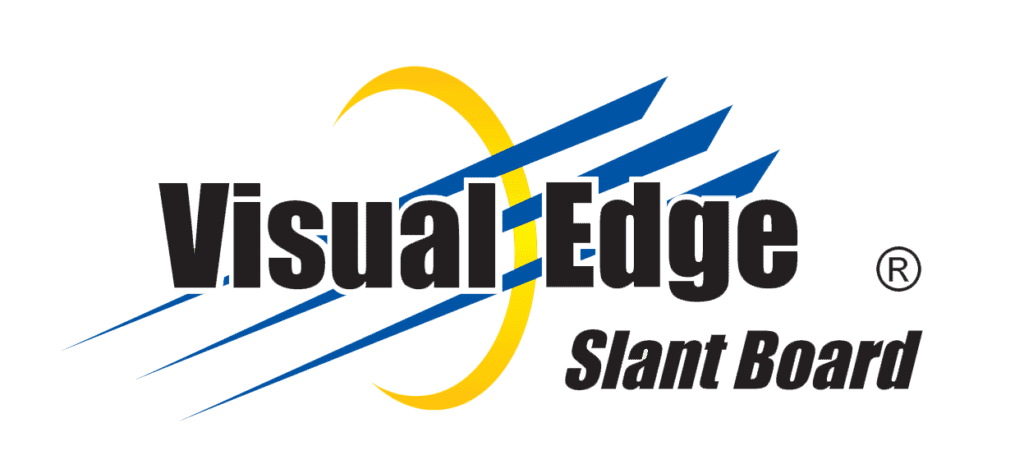What issues does a Visual Edge Slant Board address?
How it Works for Reading
Your brain recognizes letters as symbols that when put together into words become a code that your brain translates into information.
As you read down a page on a flat surface, the letters change shape due to the changing angle of your vision. This constant adjusting causes your brain to work harder to interpret what you are reading. This results in increased fatigue and reduced comprehension.
When using our slanted workstation, the letters remain consistent throughout the page thus allowing your brain to decode only one set of symbols. Like a computer, your brain processes the information more efficiently resulting in better comprehension and less fatigue.
How it Works for Writing
Slanted workstations have been used by architects, graphic designers and schools for centuries as it provides many benefits while writing or drawing.
When writing on a flat surface, you use only your wrist muscles which will lead to strain and less control. When raising your arm on a slanted workstation you incorporate many more muscle groups resulting in better penmanship and less fatigue.
This is why we want to provide you with the ultimate tool for reading and writing.

Promotes “Vision Hygiene” When Reading & Working
An effective sloping work surface must be tilted at an angle between 20 and 23 degrees from the horizontal. The Visual Edge Slant Board rests at 22 degrees, the research-proven optimum angle.

Reduce Stress
The Visual Edge Slant Board in combination with the proper sitting height allows you to naturally move into a posture that is conducive to a better learning environment. You will naturally sit more upright and bend your head less. This will lead to a reduced heart rate, a more regular and deeper breathing pattern and reduced neck muscle and overall body tension. Learn More on how to reduce reading stress.

Improved Comprehension
As shown by research, the appropriately slanted work surface will present all text characters and images at the same prospective. Because your brain is working less to interpret text, it is easier for you to understand what you have just read.

Improved Penmanship
When you write on a flat surface you utilize only the muscles in your wrist. When you raise your arm up at an angle you incorporate the use of your forearm muscles. Thus giving you more control and having less fatigue.

Reduce Eye Fatigue
When doing any visual task on a flat surface your brain has to work harder as it scans down the page because the angle at which your brain perceives the symbols and or images is changing. The scientifically proven angle of 22 degrees reduces strain on your eyes because the text remains in focus down the entire page.

Lower Blood Pressure & Improve Heart Rate
Due to your improved posture, less stress is placed on your body resulting in lower blood pressure. An additional benefit of your improved posture is the reduced effort required to get blood to your brain resulting in a lower heart rate.
Common Questions People Ask About Slant Boards
The Visual Edge Slant Board reduces stress placed on the optic system and promotes “Vision Hygiene” when reading and working.
Remember when all school desks were slanted? An effective sloping work surface must be tilted at an angle between 20 and 23 degrees from the horizontal. The Visual Edge Slant Board rests at 22 degrees, the research-proven optimum angle.
When reading or any visual task on a slanted surface at the appropriate angle the whole page of is put in focus. This allows for less fatigue and easier tracking when reading or viewing images as the eyes do not have to refocus as you scan down the page.
The Visual Edge Slant Board is designed to help not just this 25% segment of the population, but EVERYONE! The Visual Edge Slant Board addresses this processing issue and much more. In addition to helping with your visual processing it helps with your penmanship by engaging the use of your forearm muscles, giving you more control and having less fatigue.
Pioneering research by Dr. Darrel Boyd Harmon and subsequent research by Drs. John Pierce and Steven Greenspan clearly prove a reduction of stress and improved performance when conditions are arranged properly for near-point visual activities such as reading and writing. It has been determined through research and practical use that 22 degrees to be the optimum angle.
As shown by research, the appropriately slanted work surface will present all text characters and images at the same prospective. This allows the brain to spend less time trying to figure out what it is seeing and reading, spending more time understanding what it has just read. Additionally by using the Visual Edge Slant Board it naturally induces better posture for the user naturally moving you into the proper position to achieve the Harmon Distance.
The “Harmon Distance” is the optimal distance from the eyes to the working surface. It is the distance from the elbow to your fist knuckles. This can only be assured with a proper chair height to desk relationship.
Reading and writing are derivatives of vision and speech. As such there are numerous factors that cause difficulties. The symptoms vary, however there are key indicators that will be indicative of reading difficulties. Some of which are, red, sore, or itching eyes, head tilting, closing or blocking one eye when reading, Avoidance of near work, family history of literacy learning problems. Please refer to our section titled “SYMPTOMS OF PROBLEMS THAT LEAD TO READING DIFFICULTIES” for a more complete list.
20/20 eyesight represents only a very small part of the vision process. Behavioral optometrists differentiate between the terms “sight” and “vision”. “Sight” is the ability to see and the eye’s response to light shining into it. “Vision” is the ability to interpret and understand information that comes through the eyes.
The only reliable way to determine if an individual has a “vision” or “processing” problem is to be evaluated by a Developmental Optometrist. A Developmental Optometrist can be found in your local area by referring to the College of Optometrists in Vision Development (COVD) website, www.covd.org or Optometric Extension Program Foundation (OEP Foundation) website at www.oepf.org
No! All people will benefit from using a slanted work surface to read and write. For those with processing difficulties it is essential. However, everyone using the Visual Edge Slant Board will experience the benefits of less fatigue, lower heart rate, lower blood pressure, a more even breathing pattern and less overall stress. When doing any visual task, your brain is decoding symbols. These symbols (letters and images) become code (text and pictures) which your brain processes to retrieve the information. When doing any visual task on a flat surface your brain has to work harder as it scans down the page because the angle at which your brain perceives the symbols, images is changing, thus changing the code. This makes understanding the information more difficult for all people. The Visual Edge Slant Board creates a better learning environment for all!
